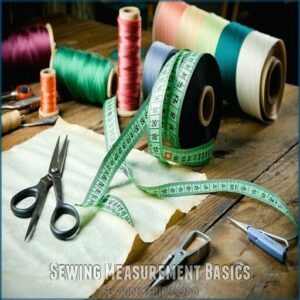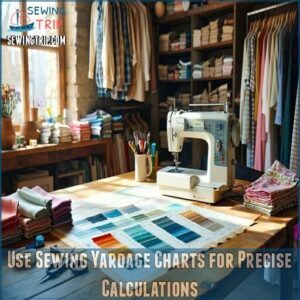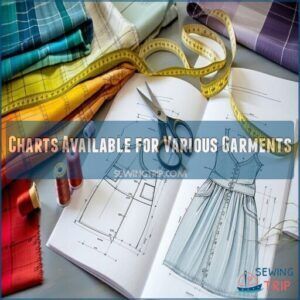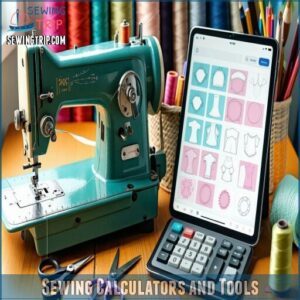This site is supported by our readers. We may earn a commission, at no cost to you, if you purchase through links.

For garments, measure your body and compare with pattern requirements. Multiply width by length for simple rectangular projects, accounting for pattern direction and repeats.
Don’t forget extra fabric for matching patterns or fixing mistakes—the carpenter’s "measure twice, cut once" applies perfectly to sewing too!
Divide your total inches by 36 to convert to yards, then round up to the nearest quarter yard. Proper calculations save you from that mid-project panic when you realize you’re inches short of finishing, which is why measure twice and cut once are crucial steps.
Table Of Contents
Key Takeaways
- Measure your project dimensions, add seam and hem allowances, and double-check to avoid fabric shortages.
- Use sewing yardage charts or calculators to ensure accurate fabric estimates and reduce waste.
- Account for pattern repeats, fabric width, and grain direction in your calculations.
- Plan extra fabric for mistakes and matching patterns to avoid mid-project interruptions.
Sewing Measurement Basics
Getting measurements right is the first step to sewing success. When you measure carefully and plan ahead, you save fabric, time, and frustration.
Measure Twice Cut Once
Measure twice, cut once" isn’t just a saying—it’s your best weapon against wasted fabric and costly mistakes.
By double-checking measurements, your cuts will be accurate, saving time and money while boosting confidence.
Careful planning reduces waste, supports precise sewing math, and confirms fabric yardage fits your project.
Embrace this small step for huge sewing success, as it is a crucial part of the process that helps avoid mistakes and ensures that your project turns out as planned.
Predetermine Finished Project Size
Knowing your project’s finished size is the compass for successful sewing.
Whether it’s garment fit, home decor sizing, or pattern adjustments, clear size considerations guide your sew calculation.
This helps refine fabric yardage and fabric requirements.
Get precise yardage calculations by considering the project scope upfront—it’s like drawing the map before the journey.
Accurate fabric calculation saves time and stress, and helps you plan your project with clear size considerations in mind.
Calculate Material Needs Accurately
You’ve planned your project size—now let’s figure out fabric needs.
Start with your pattern layout, accounting for fabric width and grain direction. Add extra for seam allowances and project complexity.
A careful fabric calculation guarantees accurate yardage estimation. This yardage calculation avoids surprises and helps you meet fabric requirements with ease.
Calculate fabric well, and you’ll save time and money, ensuring a successful project with accurate yardage estimation.
Calculate Sewing Fabric Needs
Before you cut into any fabric, it’s vital to calculate fabric needs carefully. This can prevent fabric waste and save you from running short at the worst moment.
Start by checking your sewing pattern for guidelines on fabric yardage and verify it aligns with the fabric width you’re buying. Don’t forget to factor in pattern layout, seam allowances, and a hemming allowance for a polished finish. Remember to account for fabric drape properties to guarantee the final garment hangs correctly.
Here’s how to break it down:
- Measure precisely: Add room for hemming and seam allowances to avoid miscuts.
- Adjust for pattern repeats: Especially with designs; fabric consumption increases with complex layouts.
- Double-check calculators: Use a sewing estimate tool and compare it to your own math for accuracy.
A little planning guarantees you’ll calculate fabric needs without stress while achieving stunning results for any project!
Sewing Yardage Charts
Sewing yardage charts take the guesswork out of fabric shopping by giving you clear measurements for any project.
They’re a handy guide for planning clothing, home decor, and more with ease.
Use Sewing Yardage Charts for Precise Calculations
Sewing yardage charts are your secret weapon for fabric estimation. They’re precise and prevent material waste while saving time and headaches during project planning.
Use them to match fabric widths and project needs effortlessly. Here’s a quick guide:
| Fabric Width | Project Type | Yardage Needed |
|---|---|---|
| 32″ | Kid’s T-shirt | 1 5/8 yards |
| 44-45″ | Adult Shirt | 2 yards |
| 50″ | Cushion Covers | 1 yard |
| 58-60″ | Dress Fabric | 1 3/4 yards |
| Varies | Pattern Repeats | Formula Needed |
This guide helps in precise fabric estimation and prevents material waste. It is essential for saving time and ensuring that your projects are well-planned and executed without headaches.
Charts Available for Various Garments
You’ll find charts for five key garment types to help calculate fabric needs with precision.
These charts eliminate guesswork and save you money on your sewing projects.
| Garment Type | Standard Fabric Width | Typical Yardage Range |
|---|---|---|
| Shirts | 45" or 60" | 1.5-3 yards |
| Pants | 45" or 60" | 2-3.5 yards |
| Dresses | 45" or 60" | 2.5-5 yards |
| Skirts | 45" or 60" | 1-3 yards |
| Jackets | 45" or 60" | 2-4 yards |
Pattern layout optimization helps maximize fabric efficiency with these garment charts to achieve precision in calculating fabric needs, which is crucial for sewing projects and helps eliminate guesswork.
Includes Measurements for Adult and Children’s Clothing
Your sewing yardage charts wouldn’t be complete without specific measurements for both adults and children.
These thorough guides take the guesswork out of fabric shopping.
| Size Category | Fabric Width Impact | Pattern Adjustments |
|---|---|---|
| Infant (0-24m) | Less fabric needed | Simpler construction |
| Child (2-12) | Width varies by age | Allow growth room |
| Adult (XS-3XL) | Width increases | Consider proportions |
Remember, children’s size charts require less fabric but often need extra for growth allowances.
Accurate pattern making relies on precise body measurements for the best fit.
Provides Fabric Requirements for Home Decor
When flipping through sewing yardage charts, you’ll find handy fabric requirements for all your home decor projects.
Never guess how much material you’ll need again!
| Project Type | Fabric Width | Small Size | Medium Size | Large Size |
|---|---|---|---|---|
| Curtains | 45" | 2 yards | 4 yards | 6 yards |
| Cushions | 54" | ½ yard | 1 yard | 1½ yards |
| Aprons | 45" | 1 yard | 1½ yards | 2 yards |
| Tablecloths | 54" | 1½ yards | 2½ yards | 3½ yards |
| Ironing Board Covers | 45" | ¾ yard | 1 yard | 1¼ yards |
Sewing Calculators and Tools
You’ll save time and prevent fabric waste by using sewing calculators that do the math for you.
These handy tools quickly convert measurements, calculate yardage needs, and guarantee you buy exactly what you need for your project, which helps to prevent fabric waste.
Sewing Calculator Overview
While yardage charts offer helpful guidance, a sewing calculator takes the guesswork out of fabric planning. This handy tool computes measurements when you know two out of three variables: pattern piece count, piece length, or total yardage needed.
Three ways a sewing calculator saves you time:
- Automatically converts between inches and centimeters
- Accounts for pattern piece dimensions precisely
- Eliminates manual calculation errors
Never waste fabric again—let calculation accuracy become your new best friend! Selecting the right sewing notions and tools can also help with project planning to achieve better results.
Sewing Fabric Yardage Calculator Overview
Managing fabric estimations becomes stress-free with a reliable yardage calculator.
This handy tool provides accurate fabric yardage for dresses, curtains, and quilts.
You’ll save time and money by purchasing exactly what you need.
The calculator’s resource efficiency means less waste in your sewing room.
Input your measurements once, and you’ll get precise material estimations for any project—no more guesswork or emergency fabric runs!
Consider using a fabric measurement tool to confirm accuracy and make your sewing process more efficient.
Automatically Converts Units
Our fabric yardage calculator makes math a breeze with automatic unit conversion.
No more headaches switching between metric and imperial measurements.
Simply enter your dimensions in your preferred units, and the calculator instantly converts between inches, yards, centimeters, and meters.
This unit conversion benefit saves you time and prevents costly calculation errors, especially when working with international patterns or fabric suppliers, providing a significant advantage with automatic unit conversion.
Ensures Accurate Calculations
Beyond converting units, quality sewing calculators guarantee your measurements are spot-on every time. You’ll never waste fabric or come up short again!
Here’s how they maintain accuracy:
- They account for seam allowances automatically, adding the exact amount needed for your project
- They optimize pattern layout to minimize fabric wastage
- They factor in fabric width variations that affect your total yardage requirements, ensuring you have the right amount of fabric and minimizing wastage.
Sewing Formulas and Techniques
You’ll save time and money when you master these simple sewing formulas that take the guesswork out of fabric calculations.
With the right technique in your toolkit, you can quickly figure out exactly how much material you need for any project without making costly mistakes, using these simple sewing formulas.
Sewing Formula for Total Yardage
When planning your next project, use this simple yardage formula: multiply the number of needed pieces by their length, then divide by 36 for total yardage.
For example, if you need 4 strips each 45 inches long, that’s 180 inches total or 5 yards of fabric.
Don’t forget to round up and add extra for pattern repeats, seam allowances, and hemming calculations.
Apply Calculations to Any Sewing Pattern
Now that you’ve mastered the basic yardage formula, you can apply your calculations to any sewing pattern.
Simply take your pattern pieces, measure their length, and multiply by the number of pieces needed. Don’t forget to account for seam allowances in your measurements!
Most commercial patterns include fabric requirements, but knowing how to calculate yourself helps when you’re adjusting pattern sizes or creating your own designs.
Accurate planning requires that you calculate fabric needs to ensure you have enough material for your project, considering fabric requirements and pattern sizes for a successful outcome with accurate planning.
Account for Pattern Repeats and Fabric Width
Now that you understand basic fabric calculations, let’s tackle pattern repeats. When working with patterned fabrics, you’ll need extra material to match designs.
To calculate properly:
- Divide your finished length by the vertical repeat
- Round up to the nearest whole number
- Multiply by the repeat measurement
Don’t forget fabric width affects layout efficiency too! Narrow fabrics often require more yardage to accommodate pattern pieces with proper fabric grain orientation. Accurate pattern cutting relies on understanding body proportions.
Consider Seam Allowances and Hemming in Calculations
The hidden math of seam allowances and hems can make or break your project.
When calculating fabric needs, add 1/2 to 5/8 inch for each seam allowance and 1-3 inches for hems.
Don’t forget to account for these in your pattern layout and accurate cutting. These small measurements add up quickly, potentially turning your perfectly planned project into a fabric-shortage nightmare if overlooked.
A seam allowance product can help with this.
Frequently Asked Questions (FAQs)
What is the sewing fabric yardage calculator?
Like a trusty compass on your sewing journey, the fabric yardage calculator helps you determine exactly how much fabric you’ll need for projects like dresses, curtains, and quilts.
It prevents wasteful purchases.
How do I calculate the cost of my sewing projects?
To calculate your sewing project cost, add fabric and supplies price, like thread and buttons.
Include pattern cost, taxes, and any extras for mistakes.
Don’t forget to factor your time if selling!
How do you calculate your sewing rates?
It’s funny how time flies when you’re sewing!
To calculate rates, factor in materials, project complexity, and your hourly rate.
Add markup for profit, track hours, and don’t forget the cost of extras!
How do you calculate sewing efficiency?
To calculate sewing efficiency, track how much time you spend sewing versus how much time is productive.
Divide productive sewing time by total time, then multiply by
This shows how effectively you’re working.
How to calculate the cost of sewing thread?
To calculate thread cost, divide the spool price by its yardage to find the per-yard cost.
Multiply that by the thread length needed for your project, plus a little extra for mistakes.
What should be considered for accurate sewing cost calculation?
To calculate sewing costs accurately, factor in fabric price, thread, needles, pattern costs, and any tools you’ll need.
Don’t forget to include labor time, machine maintenance, and a small buffer for mistakes.
How to calculate measurements for sewing?
Measuring for sewing isn’t rocket science, but precision matters.
Start by noting your project’s dimensions.
Add seam allowances, account for fabric widths, and always double-check—because nobody wants a shirt that’s unintentionally “extra-snug” due to a lack of precision.
How to calculate the amount of fabric needed?
To figure out the fabric you need, first check the project size and pattern guide.
Then, include seam allowances and extra for mistakes.
Use yardage charts or a fabric calculator for accurate estimates.
How is math used in sewing?
Math in sewing is like your secret weapon.
It helps you measure fabric, calculate yardage, and plan patterns.
From basic addition to geometry, numbers guarantee everything fits perfectly—no guesswork, just precision and creativity.
What is the formula for calculating armhole?
To calculate an armhole, measure the circumference around the shoulder and underarm.
Divide it by four for your pattern.
Add seam allowances and ease for comfort.
Always double-check measurements for accuracy before cutting fabric.
Conclusion
Ready to start sewing but worried about running out of fabric? Take a deep breath—measuring carefully is your secret weapon!
By understanding how to calculate sew fabric needs, you’ll save time, money, and frustration. Measure your project, add seam allowances, and double-check your math.
Use tools like yardage charts and sewing calculators to stay accurate. Don’t forget to account for pattern repeats and extra fabric for mistakes.
Plan ahead, and you’ll sew with confidence every time, knowing you have mastered the art of measuring and calculating fabric needs to avoid running out, and thus can work with precision!













